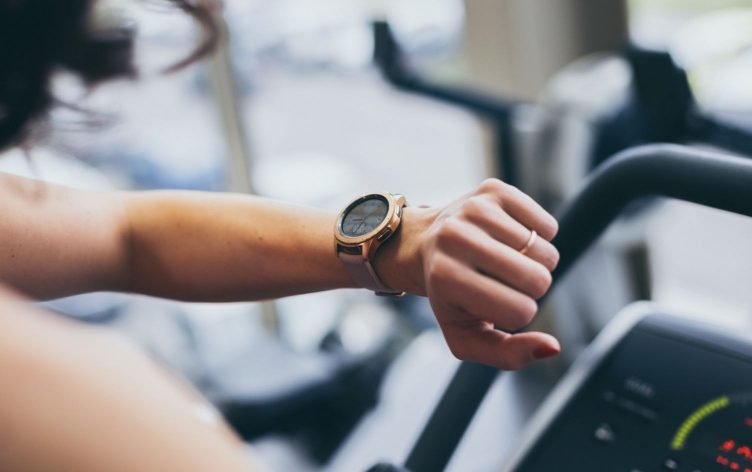
Most people believe the harder they work out, the more fat they burn. Most people are wrong.
The truth is, fat burning occurs at a much lower intensity than many of us realize. Which means, even though you’re sweating it out in the gym, you might actually be missing an opportunity to lose fat. Luckily, it’s fairly easy to find the sweet spot where your body begins to burn fat during your workout.
Finding your heart rate during training is easier than ever with advances in wearable technology, smartphone apps and cardio equipment. Your watch can give you a rough estimate of your heart rate as you work out or you can elect to use a chest strap. Now that you can collect this information so easily, you have to figure out what to do with it.
In general, your heart rate increases as your workout gets harder. That’s why the first use for measuring heart rate is to gauge the intensity of your workout. However, it’s not always reliable. For example, your heart rate is higher when you work out in a hot environment compared to one that’s cold. Your heart rate will also be higher if you’re not properly recovered.
HOW TO FIND YOUR FAT-BURNING ZONE
There is a perfect heart rate zone tailored to each individual, which burns the most fat.
Stay below this zone and you aren’t maximizing fat burn. Go above this zone and you’re only burning the food in your stomach, not getting rid of your body fat. And you might be surprised to learn the intensity level is fairly low, and you should aim to workout slightly longer at that lower intensity.
Max Heart Rate = 220 – your age x .66
To use heart rate in your own training, start by calculating your maximum heart rate. Multiply your age by .66. Then, subtract that number from 220 and you have your estimated max heart rate. For example, if you’re 30, your maximum heart rate is roughly 200. This is the most accurate way to calculate max heart rate without using technology, according to a 2017 study published in the Chinese Journal of Sports Medicine.
Once you know your max heart rate, you can calculate heart rate zones. These zones are designed to give you an idea of how hard to work during your training session. The Centers for Disease Control and Prevention (CDC) recommends sticking to 64–76% of your max heart rate for moderate-intensity activity in your fat-burning zone.
Endurance athletes who don’t want to push themselves should stay in this range. Most weightlifting workouts stay in this range as well. For a 30 year-old with a max heart rate of 200, the range extends from 128–152 beats per minute.
INTENSITY BURNS CALORIES
Vigorous-intensity workouts should be 77–93% of your max heart rate, according to the CDC. For the same 30 year-old, that’s 154–186 beats per minute. The technology you use might have different heart rate zones, but those provided by the CDC are the most credible.
When it comes to heart rate, you want to be as accurate as possible. There’s a big difference in workout intensity between 160–170 beats per minute. To get the most accurate heart rate information you’ll need some extra math.
HOW TO FIND YOUR HEART RATE RESERVE
Martti Karvonen was a Finnish scientist who wanted to figure out a more accurate way to use heart rate to determine the intensity of cardio exercise. His method is known as heart rate reserve, and it’s a more accurate way of determining the intensity of exercise according to an article from the British Columbia Medical Journal.
Kennedy Fitness explains you can find your heart rate reserve by subtracting your resting heart rate from your max heart rate. To find your resting heart rate, lie down and relax for a few minutes. You can put on a smartwatch or fitness tracker that measures heart rate or use a chest strap. If you don’t have any technology, you can put your fingers on the side of your neck to feel your pulse.
Once you feel relaxed, begin measuring your heart rate. If you can, track it over a few minutes. The average heart rate over that time is your resting heart rate. As an example, assume you have a resting heart rate of 60. If you’re 30 years old, you’d subtract that number from your max heart rate of 200. That means your heart rate reserve number is 140.
Now you can use the American College of Sports Medicine’s recommendations for exercise calculated from heart rate reserve, which are much more accurate. Take your heart rate reserve number, 140, and multiply it by one of the following intensities:
- 30% or less for very light activity
- 30–39% for light activity
- 40–59% for moderate activity
- 60–89% for vigorous activity
- 90% or above for maximal intensity
For example, if your heart rate reserve number is 140 and you want to do moderate-intensity activity, you can multiply .4 and .59 by 140. That gives you a range of 56–83 There’s one more step to figure out your target heart rate. Simply add your resting heart rate to the number you currently have. In this example, add 60 to 56 to get 116. Then, add 60 to 83 to get 143. That means your range for moderate-intensity exercise is 116–143.
While it might seem complicated, this is one of the most accurate ways to find your target heart rate without relying on fancy laboratory equipment.
Once you know your target heart rate zone you can use it to adjust your workouts. Wear your heart rate monitor of choice and change your workout intensity as you go. For interval workouts your goal can be to reach vigorous-intensity range during an exercise then drop down to a moderate or light range when you rest. For endurance workouts you can stay in a moderate-intensity range.
HOW TO CHOOSE THE RIGHT WORKOUT FOR YOUR GOALS
Choosing a workout and intensity level to reach your fat-burning zone depends on your fitness level. If you are an avid runner, for example, you’ll need to run faster to reach your fat-burning zone than someone just getting into running. Here are a few ideas for every fitness level.
FOR BEGINNERS
Many everyday activities offer low heart rate, fat-burning opportunities. Some good ones:
- Park at the back of the parking lot and walk to the entrance
- Walk the dog instead of simply tossing a ball
- Ditch your car and walk or ride your bike to lunch instead of driving
- Take the stairs
FOR RUNNERS
Long, slow, distance runs keep you in the fat-burning zone for your entire workout. A few things to keep in mind:
- Slow is the key word here. Keep your pace moderate enough to remain in your target heart-rate zone (60–70% of your max heart rate)
- Consider doing a brisk walk at first — especially if you’re new to running. As your fitness level builds, you’ll be able to trade in your walk for a steady jog, without coming out of the fat-burning zone.
- Aim to complete a long, slow distance run 3–5 times per week.
- Don’t increase your weekly total mileage by more than 10% each week to help avoid the risk of an overuse injury
FOR GYM LOVERS
Whether you work out at the gym, at home or in a park, for maximum fat-burning results, try this simple 1/3 routine.
- Perform three cardio exercises for an equal amount of time — spend 10 minutes on the treadmill, 10 minutes on the rowing machine and 10 minutes on the elliptical, for example.
- Do this workout 3–5 times per week, and mix in different types of cardio exercises to keep things interesting.
Get your heart pumping with fast-paced HIIT workouts. Go to “Workout Routines” in the app to explore HIIT workouts and more.







